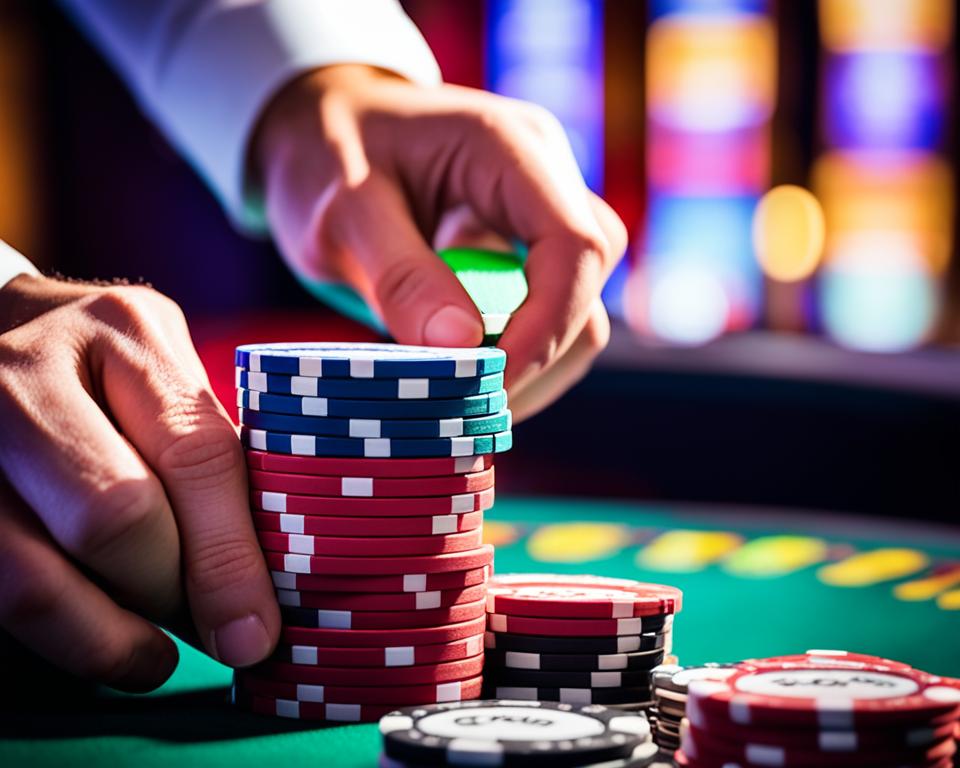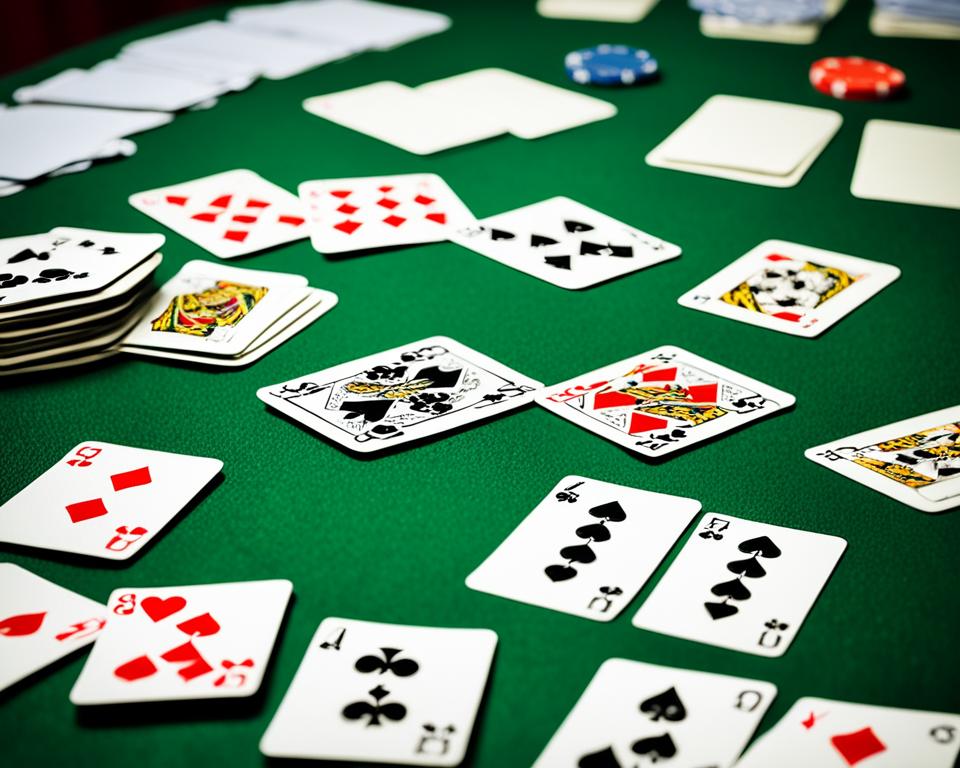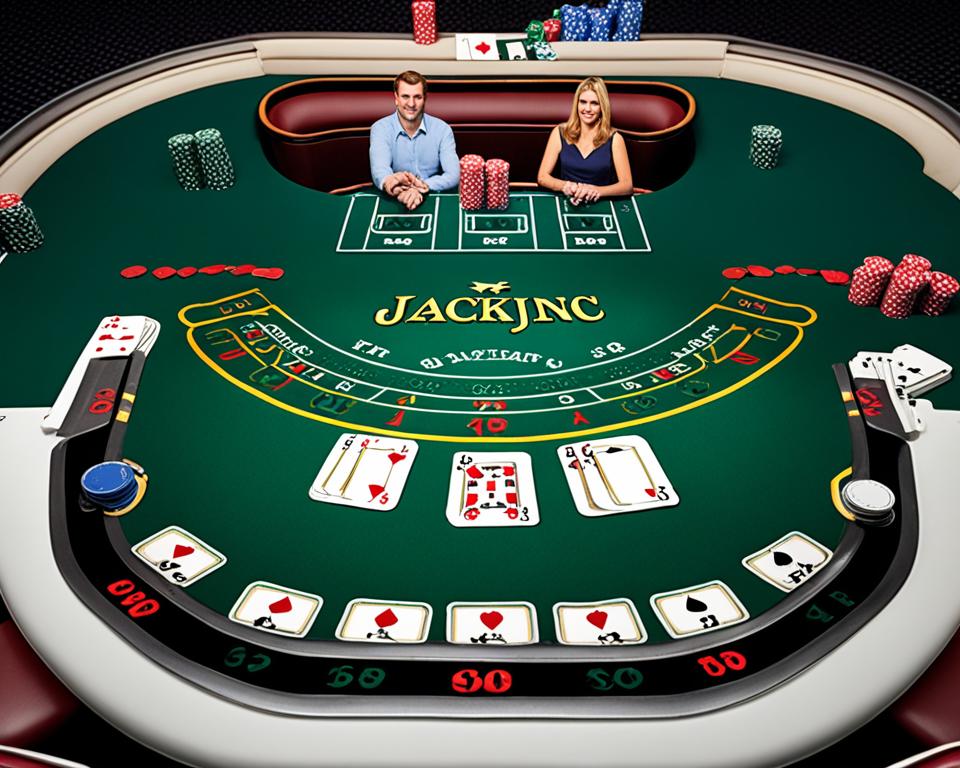Looking to learn how to play blackjack? You’ve come to the right place! This blackjack for beginners tutorial is a quick start guide that will walk you through the basics of the game and provide you with the knowledge you need to play with confidence. Whether you’re new to the casino scene or just want to brush up on your skills, this beginner’s guide to blackjack has got you covered.
Key Takeaways:
- Understand the basic rules of blackjack, including card values and the objective of the game.
- Learn how to place bets and deal cards in a blackjack game.
- Make informed decisions during gameplay by knowing when to hit or stand.
- Discover strategies and optimal gameplay techniques to maximize your chances of winning.
- Practice responsible gambling and manage your bankroll effectively.
Understanding the Basic Rules of Blackjack
In blackjack, players place bets and are dealt two cards. The dealer also receives two cards, one face-up and one face-down. The objective is to have a hand with a total closer to 21 than the dealer’s hand without going over 21. Face cards are worth 10, and Aces can be worth 1 or 11.
Players can choose to hit (take another card) or stand (keep their current hand) based on the value of their cards and the dealer’s face-up card. The dealer must draw cards until their hand totals 17 or more.
A cheat sheet or blackjack chart can help players make optimal decisions based on their hand and the dealer’s card.
Placing Bets and Dealing Cards
Before the round begins, players must place their bets using chips or other betting materials. The excitement builds as the anticipation of the upcoming game fills the air. Once all bets are in, the dealer takes control, ready to deal the cards that will determine the outcome of each player’s hand.
The dealer starts by giving each player and themselves one card face-up. The cards are placed on the table, making it easy for players to see each other’s hands. This transparency adds an element of strategy to the game, as players can gauge the strength of their opponents’ hands.
Next, each player receives a second card face-up, while the dealer takes a card face-down. The uncertainty of the dealer’s face-down card adds an element of suspense to the game, keeping players on the edge of their seats. It’s a thrilling moment that can either confirm their confidence in their hand or raise doubts.
With the cards dealt, players have a glimpse of their starting hand, and the decision-making process begins. They must analyze the value of their cards, taking into account the dealer’s face-up card and the blackjack strategies they have learned. It’s a crucial moment where the fate of their bets hangs in the balance.
“Placing bets and dealing cards sets the stage for an exhilarating game of strategy and chance. By observing the faces around the table and making calculated decisions based on the cards they hold, players can position themselves for a successful blackjack experience.” – Blackjack Enthusiast
Card Values
| Card | Value |
|---|---|
| Ace | 1 or 11 |
| Face Cards (King, Queen, Jack) | 10 |
| Numerical Cards (2-10) | Respective Numerical Value |
Understanding the value of each card is essential for making strategic decisions during gameplay. Aces hold the potential to be either 1 or 11, providing flexibility in hand total calculations. Face cards, such as King, Queen, and Jack, carry a value of 10. Numerical cards hold their respective numerical value.
Understanding Gameplay and Deciding Whether to Hit or Stand
Gameplay in blackjack starts with the player to the left of the dealer, who must make a crucial decision: whether to hit or stand. This decision is based on the total value of the player’s hand and how it compares to the dealer’s face-up card.
When the player’s hand is close to 21 and they believe taking another card could result in going over, it’s advisable to stand and keep their current hand. On the other hand, if the player’s hand has a low total, hitting and receiving another card can potentially improve their hand.
Players continue to cycle through the options of hitting or standing until they decide to stand or they bust by going over 21. This decision-making process adds an element of strategy and excitement to the game, as players weigh the risks and rewards of each choice.
Example:
Player: “I have a hand total of 14, and the dealer’s face-up card is a 7. I think hitting would give me a better chance of improving my hand. I’ll take another card.”
Player: “Now my hand total is 20, and the dealer’s face-up card is a 10. With such a strong hand, I should definitely stand and hope the dealer doesn’t have a blackjack.”
This decision-making process is a fundamental aspect of blackjack gameplay, requiring players to analyze the current situation and make strategic choices that can greatly influence the outcome of the game.
Let’s have a look at a blackjack gameplay table to better understand when to hit or stand:
| Player’s Hand Total | Dealer’s Face-up Card | Recommended Action |
|---|---|---|
| Less than 11 | Any | Hit |
| 11-16 | 2-6 | Hit |
| 11-16 | 7-Ace | Stand |
| 17-20 | Any | Stand |
| Ace, 7 or 8 | Any | Stand |
Using this table, players can make informed decisions based on their hand total and the dealer’s face-up card, increasing their chances of success during gameplay.
Revealing the Dealer’s Hand and Determining Winners
Once all players have finished their turns, it’s time for the dealer to reveal their hand. This moment is crucial, as it determines the winners and losers in the game of blackjack. Let’s take a closer look at how the dealer’s hand is revealed and how the winners are determined.
When it’s the dealer’s turn, they will flip over their face-down card, exposing it to all players at the table. The dealer then follows a specific set of rules based on their hand total to decide their next move.
If the dealer’s hand total is 16 or less, they are required to hit and draw another card from the deck. This rule is in place to increase their chances of reaching a higher hand total and potentially beating the players.
On the other hand, if the dealer’s hand total is 17 or more, they must stay and not draw any additional cards. This rule is designed to prevent the dealer from risking going over 21 and busting.
Now, let’s talk about determining the winners. The outcome of the game depends on the comparison between the players’ hands and the dealer’s hand. Here’s how it works:
- If the dealer busts (goes over 21), all players who haven’t busted instantly win their bets.
- If the dealer doesn’t bust, players with a hand total higher than the dealer’s win their bets.
- If a player and the dealer have the same hand total, it results in a push or a tie, and the player’s bet is returned.
Bets are usually paid out at a 1:1 ratio, meaning players receive an amount equal to their original bet. However, if a player has a blackjack (a total of 21) consisting of an Ace and a 10-value card, the payout is typically higher, often at a 3:2 ratio.
To illustrate this process, here’s a simplified table outlining the possible outcomes:
| Dealer’s Hand | Player’s Hand | Result |
|---|---|---|
| Dealer busts (over 21) | Any hand that hasn’t busted | Player wins |
| Dealer doesn’t bust | Higher hand than the dealer | Player wins |
| Dealer doesn’t bust | Lower hand than the dealer | Dealer wins |
| Dealer doesn’t bust | Same hand as the dealer | Push (tie) |
| Dealer has blackjack | Any hand except blackjack | Dealer wins |
| Dealer has blackjack | Player also has blackjack | Push (tie) |
Revealing the dealer’s hand and determining the winners is an exciting moment in the game of blackjack. It adds anticipation and suspense as players eagerly await the outcome. Understanding this process is essential for players to make informed decisions and maximize their chances of winning.
Continue reading to discover advanced strategies and optimal gameplay techniques in the next section.

Advancing Strategies and Optimal Gameplay
To maximize winnings and reduce the casino’s advantage, players can utilize blackjack strategies to enhance their gameplay. These strategies are based on probability theory and computer simulations, providing players with valuable insights into the best plays for each situation. By following these strategies, players can increase their chances of winning and make the most advantageous decisions in any given hand.
Optimal gameplay in blackjack involves a deep understanding of when to hit, stand, double down, split pairs, or surrender. These decisions are crucial in determining the outcome of a hand and can significantly impact a player’s success at the table. By employing the right strategy at the right time, players can tilt the odds in their favor and optimize their chances of winning.
Key Blackjack Strategies
1. Hit or Stand: Knowing when to hit (take another card) or stand (keep the current hand) is fundamental in blackjack. Players must assess the value of their hand and compare it to the dealer’s face-up card. The decision to hit or stand should be based on the probability of improving the hand without going over 21.
2. Double Down: The option to double down allows players to double their initial bet in exchange for committing to stand after receiving one more card. This strategy is advantageous when the player has a strong hand and believes that one more card can lead to a winning total.
3. Split Pairs: When dealt a pair (two cards of the same rank), players have the opportunity to split the pair into two separate hands and place an additional bet. This strategy can be profitable when the pair’s total value is low or when splitting a pair of Aces, which can potentially result in two strong hands.
4. Surrender: Surrendering is a strategy that allows players to forfeit half of their bet and retire from the hand. This option is advisable when the player’s chances of winning are significantly low, aiding in the preservation of their bankroll.
Remember, optimal gameplay is not solely reliant on luck but on calculated decisions based on the available information. Utilizing blackjack strategies can significantly improve a player’s overall performance at the table.
By implementing these strategies and mastering the art of optimal gameplay, players can enhance their blackjack skills and increase their potential for lucrative wins. Continual practice and a deep understanding of the game’s mechanics are essential in refining these strategies over time. So, study the probabilities, analyze the scenarios, and embrace the power of optimal gameplay in blackjack.
Comparing Blackjack Strategies
| Strategy | Advantages | Disadvantages |
|---|---|---|
| Hit or Stand | Maximizes potential winnings | Relies on probability calculations |
| Double Down | Increases bet size on favorable hands | Risks additional chips on uncertain outcomes |
| Split Pairs | Expands opportunities for winning hands | Requires accurate hand value assessment |
| Surrender | Preserves bankroll in unfavorable situations | Forfeits a portion of the bet |
Utilizing the right blackjack strategy at the right moment can give players a significant advantage over the house. However, it’s important to remember that strategies are not foolproof and cannot guarantee consistent wins. Nevertheless, incorporating these strategies into your gameplay can undoubtedly improve your overall blackjack experience and increase your chances of coming out ahead.
Importance of Bankroll Management and Responsible Gambling
A crucial aspect of playing blackjack is bankroll management. It is essential to set a budget and stick to it to avoid excessive losses. Players should determine their bankroll, set limits on bets, and know how much they are willing to gamble.
Additionally, responsible gambling practices are vital for maintaining a healthy relationship with the game. Knowing when to stop playing is key to preventing excessive spending and potential financial difficulties.
“Playing blackjack responsibly means enjoying the game while ensuring that it doesn’t take a toll on your finances and personal life.”
Blackjack is a game of skill, but luck can also play a role. Managing your bankroll effectively allows you to enjoy the game without risking more than you can afford to lose. By setting limits and practicing responsible gambling, players can enhance their overall gaming experience.
Bankroll Management Tips:
- Set a budget: Determine the maximum amount of money you are willing to spend on blackjack.
- Establish betting limits: Decide on the maximum bet size for each hand.
- Track your wins and losses: Keep a record of your gambling activity to monitor your progress.
- Don’t chase losses: Avoid the temptation to make larger bets after experiencing losses.
- Take breaks: Give yourself regular breaks to clear your mind and maintain focus.
Responsible Gambling Tips:
- Know your limits: Set a time and money limit for each gambling session.
- Do not gamble under the influence: Alcohol and drugs can impair judgement and decision-making.
- Seek support if needed: If you feel that your gambling habits are becoming problematic, reach out to a support group or helpline for assistance.
- Remember it’s just a game: Approach blackjack with a mindset of entertainment rather than a way to make money.
By prioritizing bankroll management and responsible gambling practices, players can enjoy the thrill of blackjack while staying in control of their finances and well-being.
| Bankroll Management | Responsible Gambling |
|---|---|
| Set a budget | Know your limits |
| Establish betting limits | Do not gamble under the influence |
| Track wins and losses | Seek support if needed |
| Don’t chase losses | Remember it’s just a game |
| Take breaks |
Tips for Playing Blackjack at Casinos
When playing blackjack at a casino, there are a few tips to keep in mind to enhance your gaming experience and increase your chances of winning. In addition to understanding the basic rules and strategies, it’s important to learn and follow proper blackjack etiquette. By practicing good manners at the table, you’ll create a pleasant and respectful atmosphere for everyone involved.
1. Learn and Follow Blackjack Etiquette
Respecting the game and other players is essential when playing blackjack. Here are some key etiquette tips:
- Avoid touching your cards or chips once the bets are placed to maintain fairness and prevent suspicion of cheating.
- Handle your cards with one hand and keep them above the table at all times to ensure fair play.
- Avoid touching the dealer’s cards or the chips on the layout.
- Do not hand money directly to the dealer. Place it on the table, and the dealer will exchange it for chips.
- Refrain from using your phone or other electronic devices at the table to maintain focus on the game.
2. Observe Other Players
Watching and learning from other players can provide valuable insights into different strategies and playing styles. Pay attention to how they navigate their hands and make decisions, as this can help you refine your own gameplay. However, remember that each player has their own unique approach, so it’s important to find what works best for you.
3. Start with Small Bets
If you’re new to blackjack or still building your confidence, it’s advisable to start with small bets. This allows you to familiarize yourself with the game without risking significant amounts of money. As you become more comfortable and gain experience, you can gradually increase your bets to maximize potential winnings.
4. Take Regular Breaks
Playing blackjack requires concentration and mental focus. To maintain your sharpness throughout the gaming session, it’s important to take regular breaks. Stepping away from the table for a few minutes can help clear your mind and prevent fatigue, allowing you to make better decisions when you return.
5. Stay Focused on the Game
While it’s natural to engage in conversations and socialize with other players, remember to stay focused on the game. Pay close attention to the cards being dealt, the dealer’s face-up card, and the actions of other players. This attentiveness will help you make informed decisions and improve your overall gameplay.
By following these tips, you can enhance your blackjack experience at casinos. Remember to always play responsibly, set limits for yourself, and most importantly, have fun!
| Tip | Description |
|---|---|
| Learn and Follow Blackjack Etiquette | Respect the game and other players by adhering to proper blackjack etiquette. |
| Observe Other Players | Watch and learn from other players to gain insights into different strategies. |
| Start with Small Bets | Begin with smaller bets to build confidence and familiarize yourself with the game. |
| Take Regular Breaks | Rest and recharge by taking regular breaks to maintain mental focus. |
| Stay Focused on the Game | Avoid distractions and stay attentive to make informed decisions. |

Exploring Variations and Online Blackjack
When it comes to blackjack, there is a world of exciting variations and the convenience of online play. Whether you’re looking to mix up your gameplay or enjoy the game from the comfort of your own home, blackjack variations and online platforms have got you covered.
Variations of Blackjack
Blackjack has evolved over the years, giving rise to various thrilling variations. Each variation introduces unique rules and gameplay elements that add an extra layer of excitement to the traditional game. Here are a few popular variations:
- Spanish 21: In this variation, all the 10s are removed from the deck, which increases the house edge. However, players have the advantage of additional payout options, such as a 3:2 payout for a 21 made up of five or more cards.
- Pontoon: This variation of blackjack is especially popular in the United Kingdom. It features different terms for hits, stands, and busts, adding a touch of British charm to the game. Players also have the option to buy cards and aim for a five-card hand, known as a “Ponte.”
- European Blackjack: Compared to traditional blackjack, European Blackjack has a few rule differences. For example, the dealer doesn’t receive a hole card until all the players have played their hands, and players may only double down on certain totals. These variations make European Blackjack a unique and enticing option.
Exploring these variations allows players to discover new gameplay experiences, challenge themselves, and try different strategies. Each variation brings its own set of rules and twists, ensuring that no two games are ever the same.
Online Blackjack: Play Anywhere, Anytime
Online blackjack brings the thrill of the casino into your own living room, office, or even on-the-go. With the advancement of technology, players can now access a wide range of online blackjack games on their computers, tablets, or smartphones. This allows for the utmost convenience and flexibility in enjoying one of the most beloved casino games.
Online casinos offer an extensive selection of blackjack games to cater to players of all skill levels and budgets. Whether you’re a beginner or a seasoned pro, the variety ensures there’s always something for everyone. From low-stakes tables for casual players to high-roller rooms for the more adventurous, online blackjack platforms provide options to suit every player’s preferences.
Additionally, online blackjack often comes with convenient features such as autoplay, allowing players to set their desired strategy while enjoying hands-free gameplay. It also offers the opportunity to engage with fellow players through chat functions, creating a sense of community even in the virtual world.
Online blackjack is not only accessible but also safe and secure. Reputable online casinos utilize advanced encryption technology to protect players’ personal and financial information, providing peace of mind while enjoying the game.
Playing Blackjack Your Way
Whether you choose to explore the exciting variations of blackjack or indulge in the convenience of online play, the game offers endless possibilities for entertainment. The variations add a fresh twist to the classic game, while online platforms ensure that the thrill of blackjack is just a click away.
Conclusion
This comprehensive Blackjack for Beginners Tutorial has equipped newcomers with the necessary knowledge and skills to master the game. By understanding the rules, strategies, and tips presented in this tutorial, beginners can gain confidence and make informed decisions at the blackjack table.
It is important to remember the principles of responsible gambling while engaging in this exciting casino game. Setting a budget and sticking to it, as well as knowing when to stop playing, are crucial aspects of maintaining a healthy relationship with blackjack. By practicing responsible gambling, players can enjoy the game while minimizing potential risks.
Whether playing at a land-based casino or online, the strategies and techniques outlined in this tutorial can greatly enhance a player’s enjoyment and success. By applying optimal gameplay strategies and observing proper blackjack etiquette, players can increase their chances of winning and have a more immersive experience.
FAQ
What is blackjack?
Blackjack is a popular casino card game where players aim to get a higher hand than the dealer without going over 21.
How do you play blackjack?
Players place bets and are dealt two cards. The goal is to have a hand with a total closer to 21 than the dealer’s hand without going over 21.
What are the basic rules of blackjack?
Face cards are worth 10, and Aces can be worth 1 or 11. Players can choose to hit (take another card) or stand (keep their current hand) based on the value of their cards and the dealer’s face-up card. The dealer must draw cards until their hand totals 17 or more.
How do you place bets in blackjack?
Before the round begins, players must place their bets using chips or other betting materials.
How are cards dealt in blackjack?
The dealer gives each player and themselves one card face-up. After that, each player receives a second face-up card, while the dealer takes a face-down card.
How do you decide whether to hit or stand in blackjack?
Players consider the total value of their hand and how it compares to the dealer’s face-up card. If the total is close to 21, “standing” is the best option. If the total is low, “hitting” and receiving another card can be beneficial.
How is the dealer’s hand revealed, and winners determined?
Once all players have finished their turns, the dealer reveals their face-down card. If the dealer has a hand total of 16 or less, they must hit and take another card. If the dealer has a hand total of 17 or more, they must stay. Players with a higher hand than the dealer (without busting) win their bets.
What are some strategies for playing blackjack?
Players can use blackjack charts and cheat sheets to make optimal decisions based on their hand and the dealer’s card. Additionally, knowing when to hit, stand, double down, split pairs, or surrender can help improve gameplay.
Why is bankroll management important in blackjack?
Setting a budget, determining betting limits, and knowing when to stop playing are crucial for responsible gambling and avoiding excessive losses.
What tips can help when playing blackjack at casinos?
Learning and following blackjack etiquette, observing other players, starting with small bets, and staying focused on the game can enhance the overall experience.
Are there different variations of blackjack?
Yes, blackjack has various variations, such as Spanish 21, Pontoon, and European Blackjack, each with its own rules and gameplay. Online blackjack also offers the convenience of playing from anywhere.





